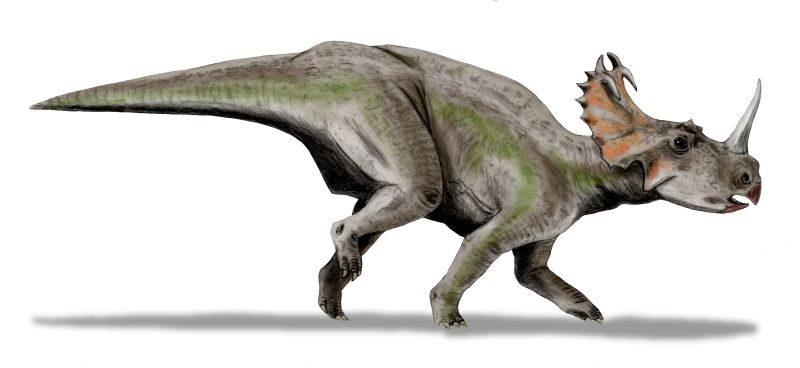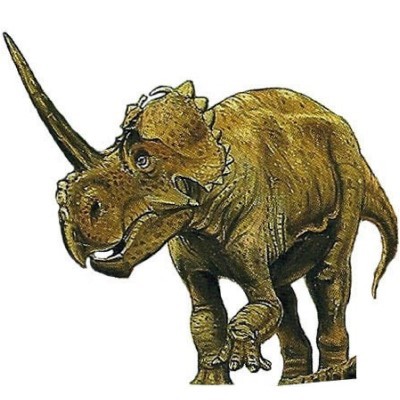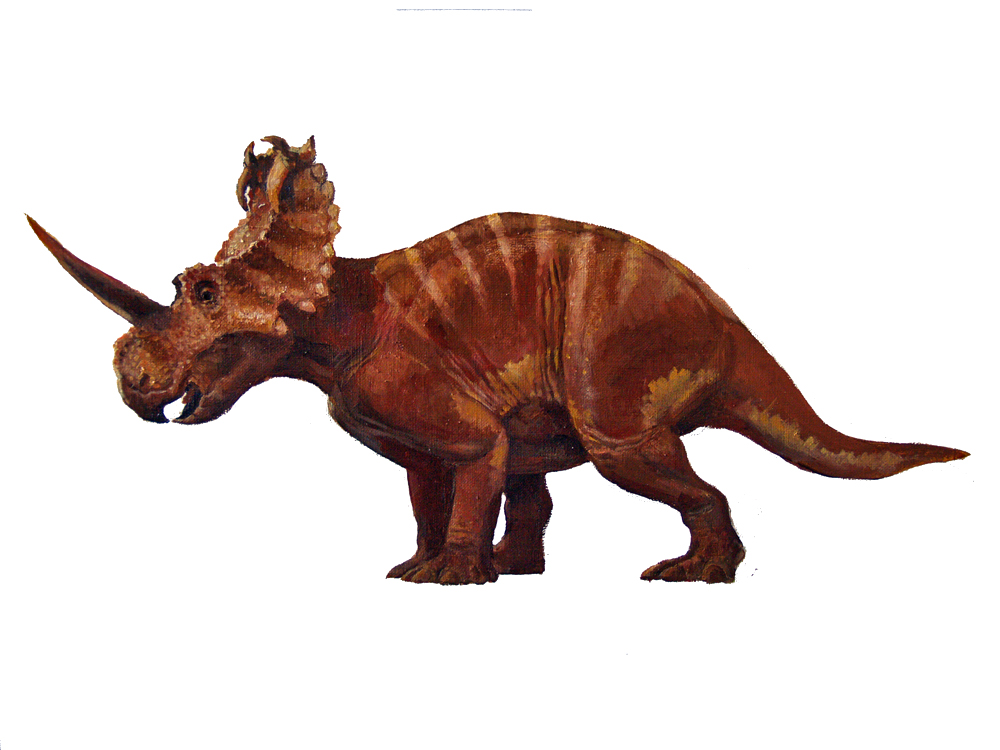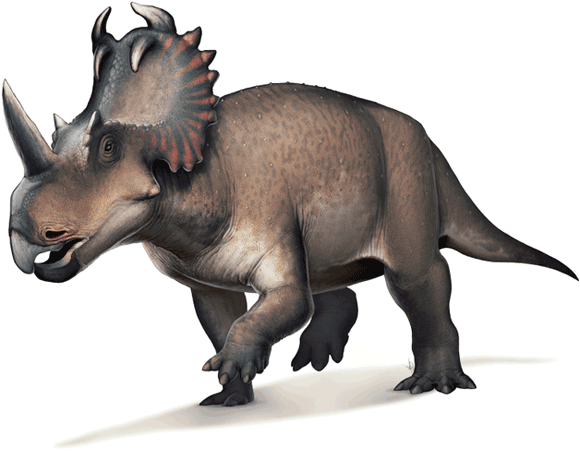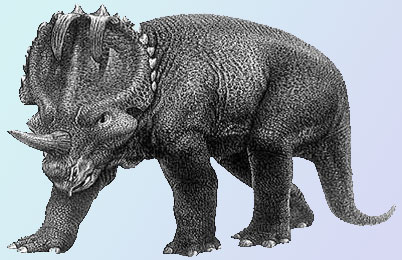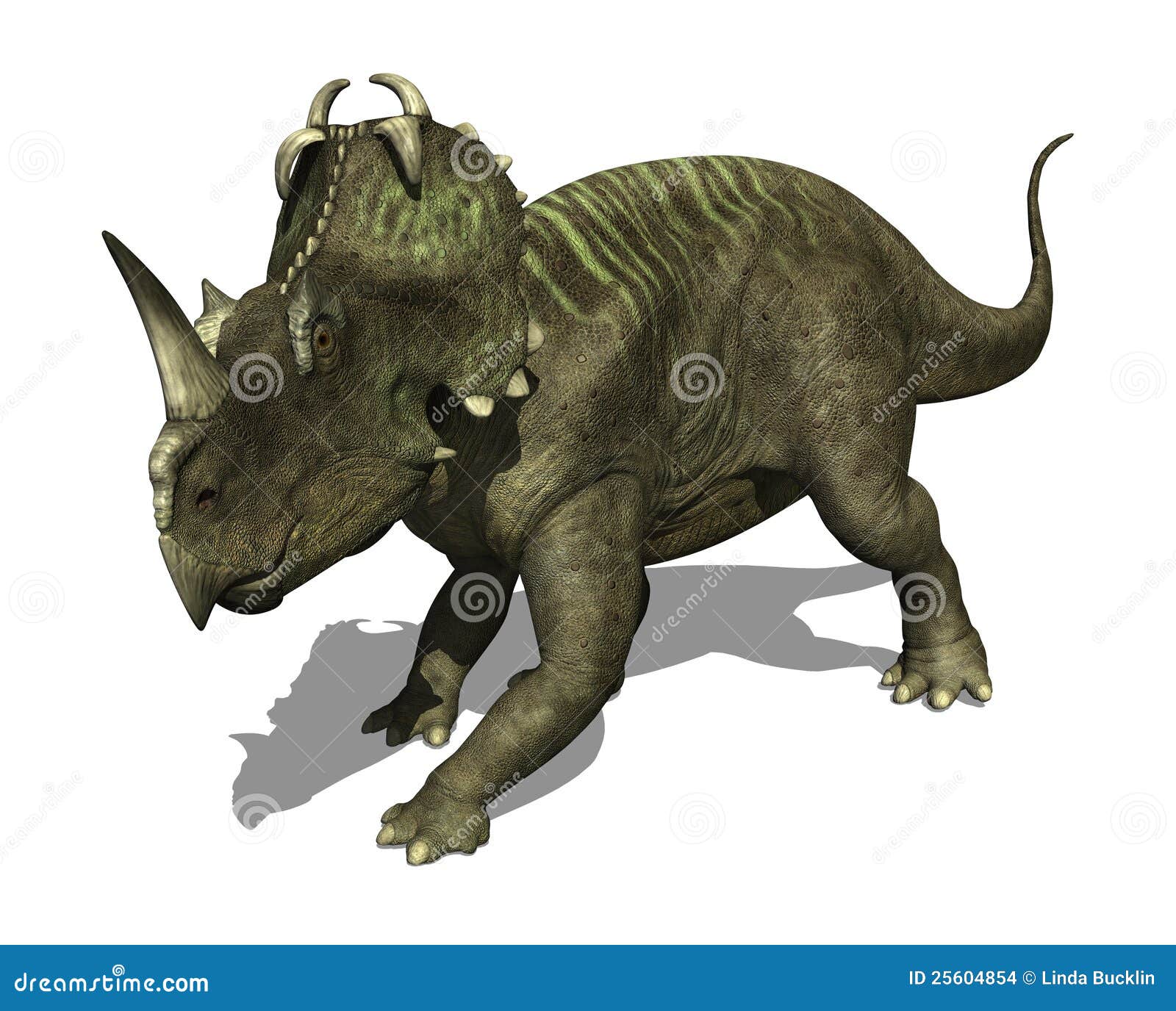Centrosaurus
Skull of Centrosaurus apertus with slightly bent backwards nasal horn, exhibited at the Royal Ontario Museum
- Alberta (Canada)
- C. apertus Lambe, 1904
- C. brinkmani Ryan & Russell, 2005
Centrosaurus ( " Sharp tip lizard" ) is a genus of dinosaur from the family of Ceratopsidae within the ceratopsians. There were quadrupede herbivore that lived in the Late Cretaceous (late Campanian ). These dinosaurs were characterized by the long nose horn and the neck plate. In addition to the already well-known in the early 20th century, the species C. apertus another species was first described in 2005 by C. brinkmani.
- 2.1 Habitat and social behavior
- 2.2 Function of the horns and neck shields
- 2.3 Posture
- 2.4 Dining
Features
General
Centrosaurus reached a length of about 6 meters and was a medium-sized representatives of Ceratopsidae, its weight is estimated at around 2.7 tons. The physique resembled that of the other Ceratopsidae, they were stocky animals with large, massive skulls and powerful limbs, the hind legs were much longer than the front legs.
Skull and teeth
He was a typical representative of the Centrosaurinae, the group with a short neck shield and longer nose horns as frontal horns. The muzzle was pointed, and was formed as with all ceratopsian from the Rostralknochen ( in front of the upper jaw ) and the Praedentale ( in front of the lower jaw). The dentition was like all Ceratopsidae from dental batteries that are in rows spaced teeth that are replaced by the following tooth when worn. There were about 28 to 31 tooth positions available. The occlusal surfaces of the teeth were approximately normal, which suggests that the teeth were mainly used for cutting activities.
The nasal bone was wearing a long horn that was curved in some copies to the front. On the forehead above the eyes Centrosaurus had two more, but very short horns that jutted upwards depending on the type ( with C. apertus ) or laterally outwardly ( with C. brinkmani ). The typical for Ceratopsidae neck shield was relatively short formed from the parietal and squamosal. He pointed to two paired openings, its edge was provided with bony protuberances ( Epoccipitalia ). In the middle of the plate edge, two hook-shaped were forward curved horns. In C. brinkmani this hook-shaped horns were equipped with small, finger-shaped growths.
Fuselage skeleton
Head and neck was associated with a massive ball joint, presumably allowing rapid movement of the head. The first cervical vertebrae were fused to Syncervical. The limbs were built sturdy and were probably provided with a powerful musculature. The pelvis is, as with all Ceratopsidae, from a board-like ilium, pubis a long extension ( Präbubis ) and a slightly curved seat leg. The legs were columnar, the feet short and strong - The front feet carried five and the hind feet four hoof-like toes.
Integument (skin)
Case of a detection of Centrosaurus remnants of the integument (skin) could be seen on the thigh. This was covered with large, roundish plates, the spaces between them were filled with small, irregularly shaped flakes.
Paleobiology
Habitat and social behavior
The excavation site of Centrosaurus (now Canadian province of Alberta) was coined in the Cretaceous Period of meandering rivers and swampy forests. From this region, other bird Beck dinosaurs as Hadrosauridae, other Ceratopsidae, Pachycephalosauria and Ankylosauria, as well as theropods Caenagnathidae, Dromaeosauridae or Tyrannosauridae and many other animals are known (see fossils of the Judith River Group).
From Centrosaurus are known bone beds ( " bone stock " ), mass deposits of hundreds of individuals. One of Philip Currie in 1978 discovered fossils box contained the remains of more than 500 individuals. It is likely that these animals lived together at least part of the year in groups. It is also a fruit are in season migratory behavior, possibly related to reproduction. It is conceivable that - similar to today's reindeer or wildebeest - in large groups crossed the rivers, while sometimes many animals were killed at the same time.
Function of the horns and neck shields
Horns and neck shields are often associated with the defense against predators in context. Against this theory, however, says that the neck shield was provided very thin and with paired windows and would have been so hardly suitable as protection against neck bites. Nor could be used for defense purposes at the plate edge, for example, the hook-shaped horns. The theory of the neck shield would act as a starting point for an enlarged jaw muscles, is discarded today. After today's perspective, the headdress was primarily the identification of the individual species as well as the interaction with other dogs - either by exhibition, threats or challenges, where it probably went to territorial boundaries or mating privileges.
Posture
The question of the posture of Centrosaurus and other Ceratopsidae has turned out to be not easy to answer. Older display these animals usually with vertical rear legs splayed wide, bent forelegs, where the humerus were held almost horizontally. Intermediate term you came from entirely by straight front legs. Recent studies suggest, however, these animals were just so kept their front legs approximately parallel to the body longitudinal plane ( parasagittal ), and with only slightly bent elbow.
Food
Centrosaurus had like all Ceratopsidae tooth batteries with approximately perpendicularly arranged occlusal surfaces. The teeth were aligned for cutting, but not be ground movement. The pointed snout is evidence of ability to selectively food intake, the construction of the lower jaw indicates a high bite force. Probably Centrosaurus fed on hard, fibrous plants.
Discovery and designation
The fossil remains of Centrosaurus were discovered in the Judith River Group in the Canadian province of Alberta and first described in 1904 by Lawrence Lambe. The name derives from the ancient Greek kentron / κέντρον ( = " spitz " ) and sauros / σαῦρος ( = " lizard" ) from and alludes to the hook-shaped horns on shield trim. ( From the same words by the way kentrosaurus, the name of a stegosaur derived. ) Type species is C. apertus, 2005, with C. brinkmani a second type described which among other things is different in construction of over eyes and shield edge horns. The finds are (late Campanian ) dated to the Late Cretaceous to an age of approximately 76.5 to 75 million years.
System
Centrosaurus is type of Centrosaurinae, one of the two subfamilies of Ceratopsidae. Its closest relative is Styracosaurus, with which it is summarized in the generic group of Centrosaurini. Subject of scientific discussion is still the question whether there is not, perhaps is the close relatives Monoclonius a synonym of Centrosaurus to juvenile or female animals.

